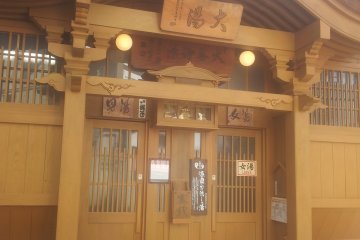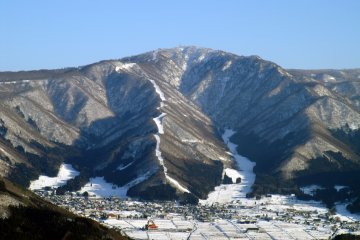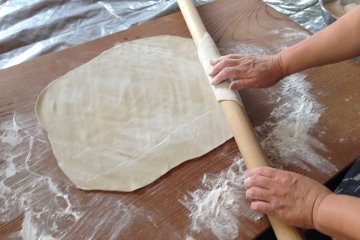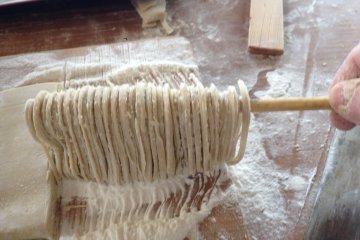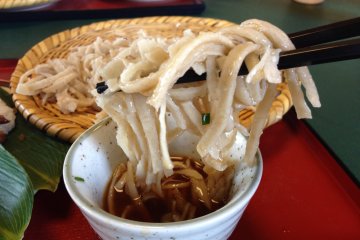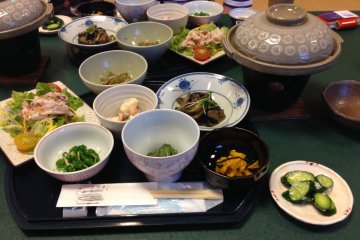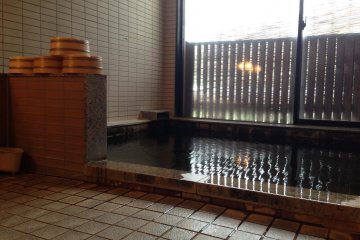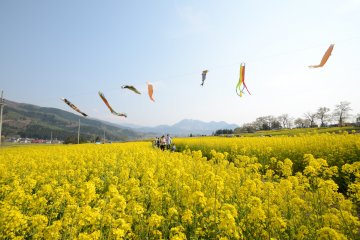Ever wonder how the Japanese make soba? I recently learned this centuries-old culinary craft by attending a special workshop known as Soba-Uchi in a Kanoe Ryokan workshop of Iiyama’s Togari Onsen area. Here you can combine your soba-making experience with the comfort and hospitality of an overnight stay at a family-run Japanese hot spring inn in the mountains of northern Nagano Prefecture.
The inn’s landlady, Ms. Kumi Kanoe, showed me how it’s done, preparing the ingredients, demonstrating each step of the process and then guiding me as I tried myself. Most of the instruction was in Japanese, but several of the friendly Kanoe family members were there to provide me with English translation. Ms. Kanoe will prepare all that is needed, demonstrate each step of the process and then watch as you try it, carefully and graciously guiding you as you go.
With the soba flour in a large, wooden bowl, I added water and kneaded the dough into a well-rounded ball before it dried out. I rolled out the dough, folded it and then cut it into thin noodles with a large knife. Ms. Kanoe made it look easy, but when I tried, I saw some pretty sloppily-cut noodles! Even so, with each batch I could start to see my progress and I started to feel like a pro in no time.
Once cut, the Kanoe family boiled the noodles and served them. It was nice to enjoy the product of my work! Though my noodles were not the best shape, they sure tasted great!
Soba-Uchi was just a part of my overnight stay experience. The warm, friendly hospitality is a mainstay of this mountainous region of northern Nagano Prefecture. The food is excellent, produced from local farms. At dinner and breakfast, you will be served all locally produced vegetables, meats, fish and rice, and Ms. Kanoe will explain what each item served is, if you wish. Most of the food is gathered from farms just a few doors down the road. Even the rice tastes better, thanks to water from a natural spring just uphill from the inn.
My stay was made complete with a dip in the soothing, comfortable water of Kanoe’s hot spring bath. The bath here is comfortable, soothing and even educational. The Kanoe family has a well-written and easy to understand explanation of proper bath etiquette, so even those unfamiliar with how to use a Japanese bath can learn and enjoy. After the bath, I took an evening stroll outside to enjoy the cool, clean air. In June, you can see hundreds of fireflies dancing over the surrounding rice fields. Far from the city, the only sounds here are of nature.
Kanoe Ryokan is one of these places where I felt like a family friend, not some anonymous visitor at a large hotel. I met three generations of the Kanoe family, and in that kind of friendly atmosphere, Soba-Uchi was much better than at some large restaurant catering to busloads of tourists. So give it a try! Get out of the city and visit Iiyama. Make your own soba and some new friends.
The Iiyama area is also known as a wonderful trekking area with many trails and beautiful woodland scenery. There are countless inns and ryokans in the area specializing in families, couples and of course homestay experiences. Most of the onsens have beautiful views of the Chikuma River. At the river you can enjoy river boating, canoeing, fishing and more. During the winter season the area transforms into a friendly ski resort with courses for all levels.





